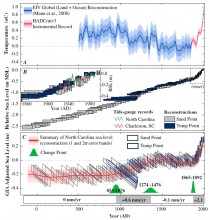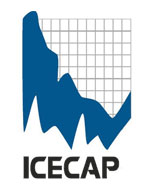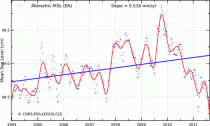By Steve Milloy
The Supreme Court stepped back from alarmist climate science in today’s decision in AEP v. Connecticut.
In the Court’s 2007 Justice Stevens-authored decision in Massachusetts v. EPA, a majority of the Court was fully in the alarmist camp. As an example, the Court held:
“The harms associated with climate change are serious and well recognized. The Government’s own objective assessment of the relevant science and a strong consensus among qualified experts indicate that global warming threatens, inter alia, a precipitate rise in sea levels, severe and irreversible changes to natural ecosystems, a significant reduction in winter snowpack with direct and important economic consequences, and increases in the spread of disease and the ferocity of weather events.”
Now contrast that position with the one stated in footnote 2 of today’s essentially unanimous opinion delivered by the liberal Justice Ginsberg:
“The Court, we caution, endorses no particular view of the complicated issues related to carbon dioxide emissions and climate change.”
Supreme panic has been replaced supreme neutrality.
We trace this change to Climategate and its progeny...the scandals that saved Western society.
By Maxim Lott, FoxNews
Is climate change raising sea levels, as Al Gore has argued—or are climate scientists doctoring the data?
The University of Colorado’s Sea Level Research Group decided in May to add 0.3 millimeters—or about the thickness of a fingernail—every year to its actual measurements of sea levels, sparking criticism from experts who called it an attempt to exaggerate the effects of global warming.
“Gatekeepers of our sea level data are manufacturing a fictitious sea level rise that is not occurring,” said James M. Taylor, a lawyer who focuses on environmental issues for the Heartland Institute.
Steve Nerem, the director of the widely relied-upon research center, told FoxNews.com that his group added the 0.3 millimeters per year to the actual sea level measurements because land masses, still rebounding from the ice age, are rising and increasing the amount of water that oceans can hold. “We have to account for the fact that the ocean basins are actually getting slightly bigger… water volume is expanding,” he said, a phenomenon they call glacial isostatic adjustment (GIA).
Taylor calls it tomfoolery. “There really is no reason to do this other than to advance a political agenda,” he said.
Climate scientist John Christy, a professor at the University of Alabama in Huntsville, said that the amount of water in the ocean and sea level were two different things. “To me...sea level rise is what’s measured against the actual coast,” he told FoxNews.com. “That’s what tells us the impact of rising oceans.”
Taylor agreed. “Many global warming alarmists say that vast stretches of coastline are going to be swallowed up by the sea. Well, that means we should be talking about sea level, not about global water volume.”
In e-mails with FoxNews.com, Nerem indicated that he considered “sea level rise” to be the same thing as the amount of water in the ocean. “If we correct our data to remove [the effect of rising land], it actually does cause the rate of sea level (a.k.a. ocean water volume change) rise to be bigger,” Nerem wrote. The adjustment is trivial, and not worth public attention, he added.
“For the layperson, this correction is a non-issue and certainly not newsworthy...[The] effect is tiny—only 1 inch over 100 years, whereas we expect sea level to rise 2-4 feet.” But Taylor said that the correction seemed bigger when compared with actual sea level increases. “We’ve seen only 7 inches of sea level rise in the past century and it hasn’t sped up this century. Compared to that, this would add nearly 20 percent to the sea level rise. That’s not insignificant,” he told FoxNews.com.
Nerem said that the research center is considering compromising on the adjustment. “We are considering putting both data sets on our website—a GIA-corrected dataset, as well as one without the GIA correction,” he said. Christy said that would be a welcome change. “I would encourage CU to put the sea level rate [with] no adjustment at the top of the website,” he said.
Taylor’s takeaway: Be wary of sea level rise estimates. “When Al Gore talks about Manhattan flooding this century, and 20 feet of sea level rise, that’s simply not going to happen. If it were going to happen, he wouldn’t have bought his multi-million dollar mansion along the coast in California.”
ICECAP NOTE: Unadjusted data. The reason they are scurrying to adjust.
“[W]hen data conflicts with models, a small coterie of scientists can be counted upon to modify the data to agree with models’ projections,” says MIT meteorologist Dr. Richard Lindzen.
UKMet’s principle research scientist John Mitchell: “People underestimate the power of models. Observational evidence is not very useful,” adding, “Our approach is not entirely empirical.”
--------
On Queu, enter Michael Mann, Rahmstorff…
Mann’s new sea level hockey stick paper
Anthony Watts, Watts Up With That
WUWT readers may recall yesterday where
Dr. Mann was so eager to list this paper on his resume/CV, he broke the embargo set for 15:00 EST June 20th, today, at which time this blog post appears.
As much as this is an editorial target rich environment, I’m going to publish this press release and paper sans any editorial comment. There’s plenty of time for that later. Let’s all just take it in first. Below, figure 2 from the Kemp et al 2011 paper. It should look familiar. Note the reference in Figure 2 to GIA (Glacial Isostatic Adjustment) adjusted sea level data, which has recently been the subject of controversy, it was first noted here on WUWT.

Fig. 2. (A) Enlarged. Composite EIV global land plus ocean global temperature reconstruction (1), smoothed with a 30-year LOESS low-pass filter (blue). Data since AD 1850 (red) are HADCrutv3 instrumental temperatures. Values are relative to a preindustrial average for AD 1400-1800 (B) RSL reconstructions at Sand Point and Tump Point since BC 100. Boxes represent sample specific age and sea-level uncertainties (2σ![]() . Inset is a comparison with nearby tide-gauge data. (C) GIA-adjusted sea level at Sand Point and Tump Point expressed relative to a preindustrial average for AD 1400–1800. Sealevel data points are represented by parallelograms because of distortion caused by GIA, which has a larger effect on the older edge of a data point than on the younger edge. Times of changes in the rate of sea-level rise (95% confidence change-point intervals) are shown. Pink envelope is a nine degree polynomial to visually summarize the North Carolina sea-level reconstruction.
. Inset is a comparison with nearby tide-gauge data. (C) GIA-adjusted sea level at Sand Point and Tump Point expressed relative to a preindustrial average for AD 1400–1800. Sealevel data points are represented by parallelograms because of distortion caused by GIA, which has a larger effect on the older edge of a data point than on the younger edge. Times of changes in the rate of sea-level rise (95% confidence change-point intervals) are shown. Pink envelope is a nine degree polynomial to visually summarize the North Carolina sea-level reconstruction.
First the press release:
Embargoed for release: 20-Jun-2011 15:00 ET
(20-Jun-2011 19:00 GMT)
Contact: Evan Lerner
elerner@upenn.edu
215-573-6604
University of Pennsylvania
Penn researchers link fastest sea-level rise in 2 millennia to increasing temperatures
PHILADELPHIA - An international research team including University of Pennsylvania scientists has shown that the rate of sea-level rise along the U.S. Atlantic coast is greater now than at any time in the past 2,000 years and that there is a consistent link between changes in global mean surface temperature and sea level.
By Patrick Michaels, Forbes
Publishing in the scientific literature is supposed to be tough. Submit a manuscript to a reputable journal and it will go through “peer review,” where your equals criticize your work, send their comments to a journal editor and then the editor will decide whether to accept your submission, reject it outright, or something in between.
In order to limit any bias caused by personal or philosophical animosity, the editor should remove your name from the paper and send it to other experts who have no apparent conflict of interest in reviewing your work. You and the reviewers should not know who each other are. This is called a “double blind” peer review.
Well, this is “the way it is supposed to be.” But in the intellectually inbred, filthy-rich world of climate science, where billions of dollars of government research money support trillions of dollars of government policy, peer review has become anything but that.
There is simply no “double blindness.” For reasons that remain mysterious, all the major climate journals leave the authors’ names on the manuscripts sent out for review.
Economists, psychologists and historians of science all tell us (and I am inclined to believe them) that we act within our rational self-interest. Removing the double-blind restriction in such an environment is an invitation for science abuse.
What about if my professional advancement is dependent upon climate change monies (which applies to just about every academic or government climatologist)? I’m liable to really like a paper that says this is a horrible and important problem, and likely to rail against an author who says it’s probably a bit overblown. May God have mercy on any manuscript that mentions the rather large elephant in the room, which is that we probably can’t do much about it anyway.
Such “confirmation bias” has been noted and studied for years, but the response of science in general - and atmospheric science in particular - has only been to make things worse.
Peer review has become “pal review.” Send a paper to one of the very many journals published by the American Geophysical Union - the world’s largest publisher of academic climate science - and you can suggest five reviewers. The editor doesn’t have to take your advice, but he’s more likely to if you bought him dinner at the last AGU meeting, isn’t he? That is, of course, unless journal editors are somehow different than government officials, congressmen, or you.
Or, if you get wind that someone is about to publish something threatening your gravy train, maybe you can cajole the editor to keep it out of print for a year while you prepare a counter-manuscript.
That’s what the “Climategate” gang did with the International Journal of Climatology whn University of Rochester’s David Douglass submitted a paper. His work showed that a large warming at high altitudes in the tropics - one of the major ways in which the enhanced greenhouse effect is supposed to change the climate - isn’t happening. For the gory details, click here. The story on this one is still unfolding as the journal has declined to publish a sequel to the counter-manuscript.
Or you could simply ignore manuscripts sent to you that find problems with temperature histories.
But there has to be a gold standard somewhere, right? Perhaps the Proceedings of the National Academy of Sciences (PNAS)?
Dream on. If you are a member of the National Academy, you can submit four manuscripts a year, called “contributed papers” as long as you do the “peer review” yourself! That’s right: you send your manuscript to two of your friends, and then mail your paper along with their comments. Again, pal review.
The PNAS editor then rubber-stamps the results. In fact, the editor probably goes through quite a few rubber stamps a year, given that only 15 of the 800-odd contributed papers submitted in the last year were rejected. For comparative purposes, Nature would have accepted only about 50 out of that number.
A recent paper submitted to PNAS by National Academy member Richard Lindzen was afforded special treatment. The editor insisted that it be held to a different standard of review because of its “political implications.” Lindzen’s research found that carbon dioxide warming is likely to be much lower than what is being calculated by current climate models.
So what about the legion of alarmist papers from NASA firebrand James Hansen that PNAS publishes via pal review? Don’t they have “political implications” too? In the mind of our National Academy, apparently some political implications are more equal than others.
There’s a lot of confirmation bias working in Hansen’s favor, because it’s back to the back of the plane for ham-and-egger climate scientists if Lindzen is right. That’s where the “political implications” get personal.
There’s a lot more to this story. Lindzen eventually published his paper - which actually benefited from a real review - in an obscure journal. But the next time you think that peer review is unbiased, think of confirmation bias, pal review and Climategate, and try to figure a way out of the mess that climate science has gotten itself into.
Patrick J. Michaels is Senior Fellow in Environmental Studies at the Cato Institute and author and editor of “Climate Coup: Global Warming’s Invasion of our Government and our Lives.”



